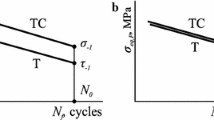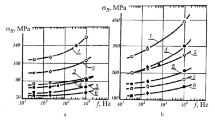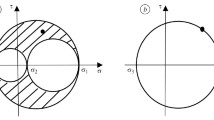We analyze the comparison of the fatigue characteristics and, in particular, the coefficients of tensioncompression and cyclic torsion based on the data of available tests performed under low-cycle fatigue in various materials. The correlation of torsion and tension-compression fatigue strength coefficients does not depend on the relative slope of the fatigue diagrams used to describe plastic strains. On the basis of the performed analyses, we conclude that the ratio of the fatigue strength coefficients in tensioncompression varies, in most materials, within the range from 0.5 to \( \frac{1}{1+\nu } \). At the same time, the correlation of the strain-based fatigue coefficients in torsion and in tension-compression strongly depends on the relative slope of the plastic strain-based curves of fatigue life.


Similar content being viewed by others
References
J. Albinmousa, H. Jahed, and S. Lambert, “Cyclic axial and torsional behaviour of extruded AZ31B magnesium alloy,” Int. J. Fat., 33, 1403–1416 (2011).
ASTM E 739-91: Standard Practice for Statistical Analysis of Linearized Stress–life (S –N ) and Strain life (ε–N ) Fatigue Data, Annual Book of ASTM Standards, Philadelphia, 03.01, 614–620 (1998).
S. Babaei, A. Ghasemi-Ghalebahman, and R. Hajighortbani, “A fatigue model for sensitive materials to non-proportional loadings,” Int. J. Fatigue, 80, 266–277 (2015).
C. Boller and T. Seeger, Materials Data for Cyclic Loading; Parts A, B, C, D, E, Materials Science Monographs, Elsevier (1987), 42D.
X. Chen, K. An, and K. S. Kim, “Low-cycle fatigue of 1Cr–18Ni–9Ti stainless steel and related weld metal under axial, torsional and 90 out-of-phase-loading,” Fatigue Fract. Eng. Mater. Struct., 27, 439–448 (2004).
X. Chen, Q. Gao, and X. F. Sun, “Damage analysis of low-cycle fatigue under non-proportional loading,” Int. J. Fatigue, 16, 221–225 (1994).
X. Chen, S. Xu, and D. Huang, “A critical plane-strain energy density criterion for multiaxial low-cycle fatigue life under nonproportional loading,” Fatigue Fract. Eng. Mater. Struct., 22, 679–686 (1999).
O. K. Chopra, Effects of LWR Coolant Environments of Fatigue Design Curves of Austenitic Stainless Steels, U.S. Nuclear Regulatory Commission (1999), p. 55.
V. Doquet and A. Pineau, “Multiaxial low-cycle fatigue behaviour of a mild steel,” in: K. Kussmaul, D. McDiarmid, and D. Socie (editors), Fatigue Under Biaxial and Multiaxial Loading (ESIS-10), Mechanical Eng. Publ., London (1991), pp. 81–101.
A. Fatemi, Fatigue and Deformation Under Proportional and Nonproportional Biaxial Loading, PhD Thesis, University of Iowa (1985).
A. Fatemi and D. F. Socie, “A critical plane approach to multiaxial fatigue damage including out-of-phase loading,” Fatigue Fract. Eng. Mat. Tech., 11, 149–165 (1988).
M. Gladskyi and S. Shukaev, “A new model for low cycle fatigue of metals alloys under non-proportional loading,” Int. J. Fatigue, 32, 1568–1772 (2010).
Y. Gorash and H. Chen, “On creep-fatigue endurance of TIG-dressed weldments using the linear matching method,” Eng. Failure Analysis, 34, 308–323 (2013).
G. R. Halford and J. Morrow, “Low-cycle fatigue in torsion,” Proc. of the American Society for Testing and Materials, 62, 695–709 (1962).
C. Han, X. Chen, and K. S. Kim, “Evaluation of multiaxial fatigue criteria under irregular loading,” Int. J. Fatigue, 24, 913–922 (2002).
D. G. Havard and T. H. Topper, “A criterion for biaxial fatigue of mild steel at low endurance,” in: Proc. First Internat. Conf. on Struct. Mech. in Reactor Tech. (Germany, Berlin, 20–24 Sept. 1971), 6, L5/2, Berlin, Germany (1971), pp. 413–432.
H. Jahed and A. Varvani-Farahani, “Upper and lower fatigue life limits model using energy-based fatigue properties,” Int. J. Fatigue, 28, 467–473 (2006).
S. Kalluri and P. J. Bonacuse, “Cumulative axial and torsional fatigue: an investigation of loaded-type sequencing effects,” in: Multiaxial Fatigue and Deformation: Testing and Prediction, ASTM STP 1387, West Conshohocken: American Soc. for Test. and Mat., PA (2000), pp. 281–301.
F. A. Kandil, The Determination of Uncertainties in Low Cycle Fatigue Testing, Standards Measurement & Testing Project No. SMT4-CT97-2165, Issue 1 (2000), pp. 1–26.
K. S. Kim, X. Chen, C. Han, and H. W. Lee, “Estimation methods for fatigue properties of steels under axial and torsional loading,” Int. J. Fatigue, 24, 783–793 (2002).
K. S. Kim and J. C. Park, “Shear-strain based multiaxial fatigue parameters applied to variable amplitude loading,” Int. J. Fatigue, 21, 475–483 (1999).
K. S. Kim, J. C. Park, and J. W. Lee, “Multiaxial fatigue under variable amplitude loads,” J. Eng. Mat. Tech., 121, 286–293 (1999).
A. Kurek, A. Kulesa, and T. Łagoda, “Naprężeniowa charakterystyka zmęczeniowa dla zakresu małej i dużej liczby cykli,” in: Symp. “Modelowanie w Mechanice”, Ustroń 2015, Zeszyt Streszczeń, Politechnika Śląska, 54, Gliwice (2015), S. 87–88.
M. Kurek, T. Łagoda, and D. Katzy, “Comparison of fatigue characteristics of some selected materials,” Mater. Test. (Materialprufung), 56, No. 2, 92–95 (2014).
M. Kurek and T. Łagoda, “Estimation of fatigue life of materials with out-of-parallel fatigue characteristics under block loading,” Mat. Sci. Forum, 726, 181–188 (2012).
M. Kurek and T. Łagoda, “Comparison of fatigue characteristics for the same selected structural materials under bending and torsion,” Mat. Sci., 47, No. 3, 334–344 (2011).
B. F. Langer, “Design of pressure vessels for low-cycle fatigue,” J. Basic Eng., 84, 389–402 (1962).
J. Li, Z. P. Hang, Q. Sun, C. W. Li, and R.-S. Li, “A simple relationship between axial and torsional cyclic parameters,” J. Mat. Eng. Performance, 20, No. 7, 1289–1293 (2011).
H. Lin, H. Nayeb-Hashemi, and R. M. Pelloux, “Constitutive relations and fatigue life prediction for anisotropic Al-6061-T6 rods under biaxial proportional loadings,” Int. J. Fatigue, 14, 249–259 (1992).
H. Lin and H. Nayeb-Hashemi, “Effects of material anisotropy on cyclic deformation and biaxial fatigue behavior of Al-6061-T6,” in: D. L. McDowell and R. Ellis (editors), Adv. in Multiaxial Fatigue, ASTM STP 1191, American Soc. for Test. and Mat, Philadelphia (1993), pp. 151–182.
Y. Liu and S. Mahadevan, “Strain-based multiaxial fatigue damage modeling,” Fatigue Fract. Eng. Mat. Struct., 28, 1177–1189 (2005).
R. D. Lohr and E. G. Ellison, “Biaxial high strain fatigue testing of 1Cr–Mo–V steel,” Fatigue Fract. Eng. Mat. Struct., 3, 19–37 (1980).
S. S. Manson, “Inversion of the strain-life and strain-stress relationships for use in metal fatigue analysis,” Fatigue Eng. Mat. Struct., 1, 37–57 (1979).
S. S. Manson, “Fatigue: A complex subject—some simple approximations,” Exper. Mech., 193–226 (1965).
D. V. Nelson and A. Rostami, “Biaxial Fatigue of A533B Pressure Vessel Steel,” Transactions of the ASME, J. Pressure Vessel Tech., 119, 325–331 (1997).
A. Niesłony, A. Kurek, Ch. El Dsoki, and H. Kaufmann, “A study of compatibility between two classical fatigue curve models based on some selected structural materials,” Int. J. Fatigue, 39, 88–94 (2012).
A. Nitta, T. Ogata, and K. Kuwabara, “Fracture mechanics and life assessment under high-strain biaxial cyclic loading of type 304 steel,” Fatigue Fract. Eng. Mat. Struct., 12, 77–92 (1989).
T. Ogata, A. Nitta, and K. Kuwabara, “Biaxial low-cycle fatigue failure of type 304 stainless steel under in-phase and out-of-phase straining conditions,” in: K. Kussmaul, D. McDiarmid, and D. Socie (editors), Fatigue under Biaxial and Multiaxial Loading, ESIS-10, Mech. Eng., London (1991), p. 377–392.
N. Petrone, Metodologie di Progettazione a Fatica per Componenti Soggetti a Sollecitazioni Pluriassiali, PhD Thesis, University of Padova, Italy (1996).
N. Shamsaei, M. Gladskyi, K. Panasovskyi, S. Shukaev, and S. Fatemi, “Multiaxial fatigue of titanium including step loading and load path alteration and sequence effects,” Int. J. Fatigue, 32, 1862–1872 (2010).
N. Shamsaei and A. Fatemi, “Deformation and fatigue behaviors of care-hardened steels in torsion: Experiments and predictions,” Int. J. Fatigue, 31, 1386–1396 (2009).
T. D. Scharton and S. H. Crandall, “Fatigue failure under complex stress histories,” ASME J. Basic Eng., 88, 247–251 (1966).
N. Shirafuji, K. Shimomizuki, M. Sakane, and M. Ohnami, “Tension-torsion multiaxial low-cycle fatigue of Mar-M247LC directionally solidified superalloy at elevated temperature,” J. Eng. Mat. Tech., 120, 57–63 (1998).
D. F. Socie, “Multiaxial fatigue damage models, Transactions of the ASME,” J. Eng. Mat. Tech., 109, 293–298 (1987).
D. F. Socie, P. Kurath, and J. Koch, “A multiaxial fatigue damage parameter, Biaxial and Multiaxial Fatigue,” in: M. W. Brown, K. J. Miller (editors), EGF3, Mech. Eng. Publ., London (1989), pp. 535–550.
J. Szusta and A. Seweryn, “Fatigue damage accumulation modelling in the range of complex low-cycle loadings—The strain approach and its experimental verification on the basis of EN AW-2007 aluminum alloy,” Int. J. Fat., 33, 255–264 (2011).
Y.-Y. Wang and W.-X. Yao, “Evaluation and comparison of several multiaxial fatigue criteria,” Int. J. Fatigue, 26, 17–25 (2004).
H. C. Wu and C. C. Yang, “On the influence of strain-path in multiaxial fatigue failure,” J. Eng. Mat. Tech., 109, № 2, 107–113 (1987).
A. Varvani-Farahani (editor), Advances in Fatigue, Fracture and Damage Assessment of Materials, WitPress (2005).
A. Varvani-Farahani, “A new energy-critical plane parameter for fatigue life assessment of various metallic materials subjected to in-phase and out-of-phase multiaxial fatigue loading conditions,” Int. J. Fat., 22, 295–305 (2000).
S. Y. Zamrik, M. Mirdamadi, and D. C. Davis, “A proposed model for biaxial fatigue analysis using the triaxiality factor concept,” in: D. L. McDowell and R. Ellis (editors), Advances in Multiaxial Fatigue, ASTM STP 1191, American Soc. for Testing and Mater., Philadelphia (1993), pp. 85–106.
S. Y. Zamrik and R. E. Frishmuth, “The effects of out-of-phase biaxial-strain cyclic on low-cycle fatigue,” Exper. Mech., 204–208 (1973).
Author information
Authors and Affiliations
Corresponding author
Additional information
Published in Fizyko-Khimichna Mekhanika Materialiv, Vol. 53, No. 4, pp. 91–98, July–August, 2017.
Rights and permissions
About this article
Cite this article
Lagoda, T., Kulesa, A., Kurek, A. et al. Correlation of Uniaxial Cyclic Torsion and Tension-Compression for Low-Cycle Fatigue. Mater Sci 53, 522–531 (2018). https://doi.org/10.1007/s11003-018-0105-3
Received:
Published:
Issue Date:
DOI: https://doi.org/10.1007/s11003-018-0105-3




